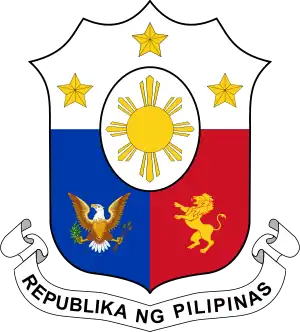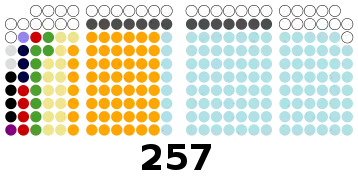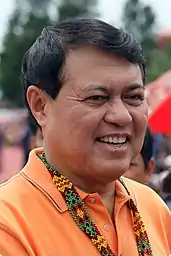1998 Philippine House of Representatives elections
Elections for the House of Representatives of the Philippines were held on May 11, 1998. Held on the same day as the presidential election, the party of the incumbent president, Fidel V. Ramos' Lakas-NUCD-UMDP, won majority of the seats in the House of Representatives.[1] For the first time since the People Power Revolution, a party won majority of the seats in the House; Lakas had a seat over the majority. This is also the first Philippine elections that included the party-list system.[2]
| |||||||||||||||||||||||||||||||||||||||||
All 258 seats in the House of Representatives (including 38 underhang seats) 130 seats needed for a majority | |||||||||||||||||||||||||||||||||||||||||
|---|---|---|---|---|---|---|---|---|---|---|---|---|---|---|---|---|---|---|---|---|---|---|---|---|---|---|---|---|---|---|---|---|---|---|---|---|---|---|---|---|---|
| |||||||||||||||||||||||||||||||||||||||||
| |||||||||||||||||||||||||||||||||||||||||
 |
|---|
|
|
However, with Joseph Estrada of the opposition Laban ng Makabayang Masang Pilipino (LAMMP; an electoral alliance between the Partido ng Masang Pilipino (PMP), the NPC and the Laban ng Demokratikong Pilipino (LDP)) winning the presidential election, the majority of the elected Lakas-NUCD-UMDP congressmen switched sides to LAMMP. This led to Manuel Villar, Jr. (formerly of Lakas but became a LAMMP member prior to the election) on being elected as the Speaker of the House.
The elected representatives served in the 11th Congress from 1998 to 2001.
Results
District elections
 | ||||
|---|---|---|---|---|
| Party | Votes | % | Seats | |
| Lakas–NUCD–UMDP | 11,981,024 | 49.01 | 111 | |
| Laban ng Makabayang Masang Pilipino | 6,520,744 | 26.68 | 55 | |
| Liberal Party | 1,773,124 | 7.25 | 15 | |
| Nationalist People's Coalition | 998,239 | 4.08 | 9 | |
| Partido para sa Demokratikong Reporma | 966,653 | 3.95 | 4 | |
| Probinsya Muna Development Initiative | 586,954 | 2.40 | 4 | |
| PDP–Laban | 134,331 | 0.55 | 0 | |
| Aksyon Demokratiko | 106,843 | 0.44 | 1 | |
| Kabalikat ng Malayang Pilipino | 47,273 | 0.19 | 0 | |
| Ompia Party | 46,462 | 0.19 | 1 | |
| People's Reform Party | 38,640 | 0.16 | 0 | |
| Kilusang Bagong Lipunan | 35,522 | 0.15 | 0 | |
| Partido Demokratiko Sosyalista ng Pilipinas | 8,850 | 0.04 | 0 | |
| Lapiang Manggagawa | 8,792 | 0.04 | 0 | |
| Nacionalista Party | 4,412 | 0.02 | 0 | |
| Pwersa ng Masang Pilipino | 2,010 | 0.01 | 0 | |
| Kilusan para sa Pambansang Pagpapabago | 1,310 | 0.01 | 0 | |
| Unaffiliated | 348,281 | 1.42 | 4 | |
| Independent | 834,934 | 3.42 | 2 | |
| Party-list seats[lower-alpha 1] | 51 | |||
| Total | 24,444,398 | 100.00 | 257 | |
| Valid votes | 24,444,398 | 83.47 | ||
| Invalid/blank votes | 4,841,377 | 16.53 | ||
| Total votes | 29,285,775 | 100.00 | ||
| Registered voters/turnout | 33,873,665 | 86.46 | ||
| Source: Nohlen, Grotz and Hartmann[3] and Teehankee[4] | ||||
- Only 14 were seated in the party-list election.
Party-list election
There were 52 seats for sectoral representatives that were contested. Each party has to get 2% of the national vote to win one seat; they would win an additional seat for every 2% of the vote, up to the maximum three seats. Only 14 party-list representatives were elected under this rule, leaving 38 unfilled seats. Eventually, the "2–4–6%" rule was ruled as unconstitutional by the Supreme Court on October 6, 2000 on the case Veterans Federation Party, et. al. vs. COMELEC.[5] Despite this ruling, no additional seats were awarded to any party-lists.
| Party | Votes | % | Seats | |
|---|---|---|---|---|
| Association of Philippine Electric Cooperatives | 503,487 | 5.50 | 2 | |
| Alyansang Bayanihan ng mga Magsasaka, Manggagawang Bukid at Mangingisda | 321,646 | 3.51 | 1 | |
| Alagad | 312,500 | 3.41 | 1 | |
| Veterans Federation Party | 304,902 | 3.33 | 1 | |
| Probinsya Muna Development Initiative | 255,184 | 2.79 | 1 | |
| Adhikain at Kilusan ng Ordinaryong Tao Para sa Lupa, Pabahay, Hanapbuhay at Kaunlaran | 239,042 | 2.61 | 1 | |
| National Federation of Small Coconut Farmers Organization | 238,303 | 2.60 | 1 | |
| Abanse! Pinay | 235,548 | 2.57 | 1 | |
| Akbayan | 232,376 | 2.54 | 1 | |
| Luzon Farmers Party | 215,643 | 2.36 | 1 | |
| Sanlakas | 194,617 | 2.13 | 1 | |
| Cooperative NATCCO Network Party | 189,802 | 2.07 | 1 | |
| Philippine Coconut Producers Federation | 186,388 | 2.04 | 1 | |
| Others | 5,725,871 | 62.54 | 0 | |
| Total | 9,155,309 | 100.00 | 14 | |
| Valid votes | 9,155,309 | 31.26 | ||
| Invalid/blank votes | 20,130,466 | 68.74 | ||
| Total votes | 29,285,775 | 100.00 | ||
| Registered voters/turnout | 33,873,665 | 86.46 | ||
| Source: Supreme Court (October 6, 2000). "G.R. No. 136781". and Nohlen, Dieter; Grotz, Florian; Hartmann, Christof (eds.). Elections in Asia and the Pacific: A Data Handbook. Vol. 2: South East Asia, East Asia, and the South Pacific. Oxford: Oxford University Press. | ||||
See also
References
- Quezon, Manuel III (2007-06-06). "An abnormal return to normality". PCIJ.org. Archived from the original on 2010-11-29. Retrieved 2010-12-06.
- "The Party-List System in the Philippines".
- Nohlen, Dieter; Grotz, Florian; Hartmann, Christof (eds.). Elections in Asia and the Pacific: A Data Handbook. Vol. 2: South East Asia, East Asia, and the South Pacific. Oxford: Oxford University Press..
- Teehankee, Julio (2002). "Electoral Politics in the Philippines" (PDF). In Croissant, Aurel (ed.). Electoral Politics in Southeast and East Asia. Singapore: Fiedrich-Ebert-Siftung. pp. 149–202 – via quezon.ph.
- Supreme Court (October 6, 2000). "G.R. No. 136781". Archived from the original on April 1, 2012. Retrieved January 16, 2017.
- Paras, Corazon L. (2000). The Presidents of the Senate of the Republic of the Philippines. Giraffe Books. ISBN 971-8832-24-6.
- Pobre, Cesar P. (2000). Philippine Legislature 100 Years. Philippine Historical Association. ISBN 971-92245-0-9.
- Teehankee, Julio. "Electoral Politics in the Philippines" (PDF). quezon.ph. Retrieved 2010-12-06.

